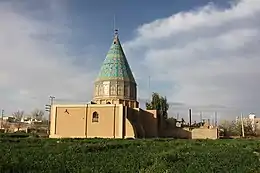Shrine of Abu Lu'lu'a
The Shrine of Abu Lu'lu'a (Persian: آرامگاه ابولؤلؤ) is a mausoleum built over what is popularly believed to be the final resting place of Abu Lu'lu'a Firuz, a Persian slave who assassinated the second Islamic caliph Umar ibn al-Khattab in 644 CE.[2] The structure was built by the Ilkhanid Mongols,[1] and is located in Kashan, Isfahan Province, Iran.[3]
| Shrine of Abu Lu'lu'a | |
|---|---|
 The shrine as photographed in September 2015 | |
 Location within Iran | |
| General information | |
| Status | Intact |
| Type | Mausoleum |
| Location | Kashan |
| Country | |
| Coordinates | 33°58′11.0″N 51°24′59.5″E |
| Named for | Abu Lu'lu'a Firuz (d. 644) |
| Completed | c. 13th–14th century CE[1] |
| Known for | Purported resting place of the assassin of Umar ibn al-Khattab (c. 584–644 CE) |
The historical Abu Lu'lu'a died in Medina (the capital of the early caliphate, situated in the Arabian Peninsula) shortly after his assassination of Umar in 644 CE.[4] However, in later times legends arose according to which Abu Lu'lu'a was saved from his pursuers by Ali ibn Abi Talib (the cousin and son-in-law of the Islamic prophet Muhammad, who is also revered by Shi'ite Muslims as the first Imam). These stories say Ali instantaneously transported Abu Lu'lu'a by means of a special prayer to Kashan, where he married and lived out the rest of his life.[5]
During the 16th-century Safavid conversion of Iran to Shia Islam, a festival started to be celebrated in honor of Abu Lu'lu'a, commemorating his assassination of Umar ibn al-Khattab.[6] Named Omar-koshan (lit. 'the killing of Umar'), it was originally held around Abu Lu'lu'a's sanctuary in Kashan, each year at the anniversary of Umar's death (26 Dhu al-Hijja of the Islamic year).[7] Later it also started to be celebrated elsewhere in Iran, sometimes on 9 Rabi' al-Awwal rather than on 26 Dhu al-Hijja.[8] The festival celebrated Abu Lu'lu'a, nicknamed for the occasion Bābā Shujāʿ al-Dīn (lit. 'Father Courageous of the Faith'), as a national hero who had defended the religion by killing the oppressive caliph.[9]
Due to political sensitivities, from the Qajar period (1789–1925) onward the festival gradually stopped being celebrated in the major cities of Iran, until it was eventually banned officially by the Islamic Republic of Iran in 1979.[10] Nevertheless, the festival itself is still celebrated in Iran, though often secretly and indoors rather than outdoors.[11] It is now held on the 9th day of the month of Rabi' Al-Awwal of the Islamic year, lasting until the 27th of the same month.[12]
In recent years, controversy was caused when al-Azhar University demanded the Iranian government demolish Abu Lu'lu'a's shrine because the shrine was considered to be "offensive and un-Islamic" by mainstream Sunni scholars. The issue caused the cancellation of diplomatic relations between the university and the Iranian government.[13] Due to this Sunni pressure, which also included an intervention by the International Union for Muslim Scholars, the Iranian government shut down the shrine in 2007.[14]
See also
- Omar Koshan, the annual festival which was originally held in honor of Abu Lu'lu'a
References
- Encyclopaedia of the Iranian Architectural History 2011; Persianblog.ir 2018.
- On Abu Lu'lu'a, see Pellat 2011.
- Algar 1990.
- Pellat 2011.
- Fischer 1980, p. 16; Johnson 1994, p. 127, note 23.
- Algar 1990; Torab 2007, p. 196.
- Johnson 1994, p. 127, note 23; cf. Algar 1990.
- Calmard 1996, p. 161; Algar 1990.
- Calmard 1996, p. 161; Johnson 1994, p. 127, note 23; Torab 2007, p. 196.
- Algar 1990; Torab 2007, pp. 194–195.
- Torab 2007, p. 195.
- Torab 2007, p. 198.
- Ismail 2016, p. 93.
- Isma'il 2007, referred to by Ismail 2016, p. 93.
Sources cited
- Algar, Hamid (1990). "Caliphs and the Caliphate, as viewed by the Shiʿites of Persia". In Yarshater, Ehsan (ed.). Encyclopædia Iranica, Volume IV/7: Calendars II–Cappadocia. London and New York: Routledge & Kegan Paul. pp. 677–679. ISBN 978-0-71009-130-7.
- Calmard, Jean (1996). "Shi'i Rituals and Power II. The Consolidation of Safavid Shi'ism: Folklore and Popular Religion". In Melville, Charles (ed.). Safavid Persia: The History and Politics of an Islamic Society. Pembroke Persian Papers. Vol. 4. London: I.B. Tauris. pp. 139–190. ISBN 1-86064-023-0.
- Encyclopaedia of the Iranian Architectural History (19 May 2011). "Encyclopaedia of the Iranian Architectural History (zip file containing xlsx file)". Cultural Heritage, Handicrafts and Tourism Organization of Iran. Archived from the original on 6 April 2015.
- Fischer, Michael M. J. (1980). Iran: From Religious Dispute to Revolution. Cambridge, MA: Harvard University Press. ISBN 9780674466159.
- Isma'il, Faraj (13 June 2007). "بعد تدخل الاتحاد العالمي لعلماء المسلمين : السلطات الإيرانية تغلق مزار "أبو لؤلؤة المجوسي" قاتل عمر بن الخطاب". Al Arabiya. Archived from the original on 15 June 2007.
{{cite web}}: CS1 maint: unfit URL (link) - Ismail, Raihan (2016). Saudi clerics and Shī'a Islam. New York: Oxford University Press. ISBN 9780190627508.
- Johnson, Rosemary Stanfield (1994). "Sunni Survival in Safavid Iran: Anti‐Sunni Activities During the Reign of Tahmasp I". Iranian Studies. 27 (1–4): 123–133.
- Pellat, Charles (2011). "Abū Loʾloʾa". In Yarshater, Ehsan (ed.). Encyclopaedia Iranica.
- Persianblog.ir (2018). "مقبره فیروزان ( مقبره ابولولو) در کاشان". abulolo.persianblog.ir. Archived from the original on 10 August 2019. Retrieved 10 August 2019.
- Torab, Azam (2007). Performing Islam: Gender and Ritual in Iran. Leiden: Brill. doi:10.1163/9789047410546_009.

